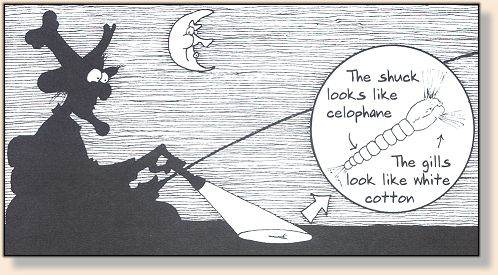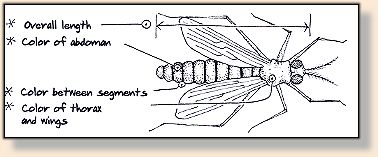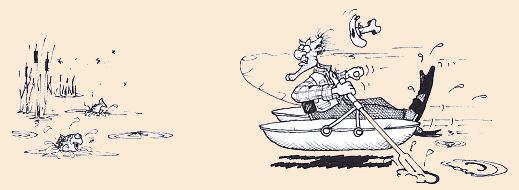
In my early days I would miss this because in the mad rush to find the
right pattern, I wouldn't take the time to look at the surface film. With
age came wisdom and I now know what to look for and stop for a
minute to determine what is causing the fish frenzy.
The four or five seconds it takes these little critters to emerge is about
the only time they are accessible to the trout after the pupae reaches
the surface. Midges don't come back in big spinner falls like the
mayflies, and I've never seen them flying low over the water like
damselflies laying eggs. Not much is written about what they
do after they leave the water.
The important time to target the adults are those few seconds when
they are leaving the water. With the right patterns you can have some
of the best dry-fly fishing around. Traditionally the patterns that
duplicate the midge are the Adams, Black Gnat, Mosquito, and the
Griffith's Gnat. But there are also Compara-Duns, and some
standard ties like the Blue-Winged Olive, that can give you
yeoman service.
Now, most species are just too small to duplicate, like the gnats, but
on most water there is a midge that will come off in size 14 through
size 10. (Up in Canada there are a few even bigger). These you can
target with standard patterns. Match the color of the abdomen as
best you can and cast to the rises. Let it set for a minute and if you
don't get a strike then repeat the process on another rise. You want
the fly to stay in the vicinity of the fish long enough for the fish to
cruise it's territory and see your fly.

Again you are fishing standard dry-fly techniques, with a floating line,
a 5X or 6X tippet. My favorite fly for this is this Compara-Dun with
a body dubbed to match the color of the abdomen. And deer hair
to match the color of the thorax.
In each population of adults there are a good number of midges
that get stuck coming out of their shuck. I think it is their extra-long
legs that get fouled, but I'm not sure. The important think is how
they act. Unable to free themselves, they buzz the surface of the
water much like a seaplane dragging a parachute. They use a lot
of energy by still remain on the surface film. They are an easy target
for the fish. If this hatch happens just before dark when the birds
are no longer a threat, I am convinced that the fish feed on these
as sort of game play.

Gently cast your fly in the direction you think the fish is going and
retrieve it fast enough that it leaves a small wake. The strikes are so
strong you may find you need to go to a heavier tippet. If the midge
is gray a standard mosquito will work.
Since this is the least addressed family of insects by the fly-tying
community, good commercial patterns are hard to come by. Check
your local fly shop. If they don't have what you need and you don't
make your own flies, then take the following instructions to the nearest
fly tier along with an adult specimen you are trying to duplicate. If you
can't get hold of a fresh adult, then note these four characteristics.
 Most of us have enough stuff to carry so a ruler is a lot of added weight.
Use your fingers and finger nails to measure as they are always handy
(no pun intended) and hard to misplace.
Most of us have enough stuff to carry so a ruler is a lot of added weight.
Use your fingers and finger nails to measure as they are always handy
(no pun intended) and hard to misplace.

You may want to tie the fly yourself. Here is a pattern - a system really -
for tying a Stillwater Midge.
With the four characteristics above you can imitate any midge on any lake.
If you tie your own flies then make a quick trip to a weaving shop that
handles some of the earthy colored wool yarns.
 I find that the most
useful colors are tan, brown, gray, green, and pink. When the pattern
calls for wool I use one strand of a three-strand hank . . . It looks
like this.
I find that the most
useful colors are tan, brown, gray, green, and pink. When the pattern
calls for wool I use one strand of a three-strand hank . . . It looks
like this.
Most adult midges are gray or tan, with other in olive, black, pink,
an' green. Here are some useful flies:
- Griffith's Gnat:
This is a great pattern for those hatches of very small midges. You
should have these from size 18 to size 22. Dead-drift your fly in the vicinity
of rising fish and don't take your eyes off the fly. If you look away you'll
never find it again.
- Black Gnat:
This is useful in smaller sizes (14-18) for those hatches of black gnats
or black flies. Dead-drift over rises.
- Compara-Dun:
This only works for larger midges, size 16 and above. The advantage is it can
often be found in the right colors at most good fly shops. Dead-drift it like
the others.
- Mosquito: This is a true midge pattern and can be used
with good succes in the right size for most midge hatches. Fish it like
you would the Stillwater Midge.
Massive midday hatches are rare and usually occur on still, overcast
days but evening hatches are a regular occurrence mid-summer through
the fall. The midges won't reach the surface all over the lake at the
same time. You might find an area has a heavy hatch but after twenty
minutes or so the area of activity has moved a couple of hundred yards
away. The rowing catamarans are the ideal platform for fishing this
situation because you can move quickly to the new area and yet stay
close enough to the surface to make sure the fish haven't switched to
caddisflies or some other bug.

When you get on one of these hatches, fish a Stillwater or a mosquito
in, or just under, the surface film so it wakes along, then hold on!!!
Keep in mind that one reason Chironomids are so effective
is that they are available year round! ~ Mike Croft
Credits: Illustrations and text by Mike Croft, from the Fish Bums
Guide to Catching Larger Trout
|





 I find that the most
useful colors are tan, brown, gray, green, and pink. When the pattern
calls for wool I use one strand of a three-strand hank . . . It looks
like this.
I find that the most
useful colors are tan, brown, gray, green, and pink. When the pattern
calls for wool I use one strand of a three-strand hank . . . It looks
like this.
 Most of us have enough stuff to carry so a ruler is a lot of added weight.
Use your fingers and finger nails to measure as they are always handy
(no pun intended) and hard to misplace.
Most of us have enough stuff to carry so a ruler is a lot of added weight.
Use your fingers and finger nails to measure as they are always handy
(no pun intended) and hard to misplace.